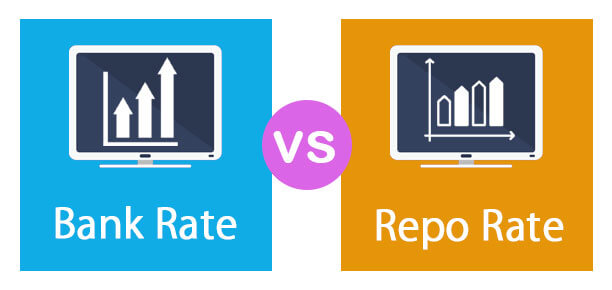Difference Between Bank Rate and Repo RateIntroduction: Bank Rate and Repo Rate
The bank rate, also known as the discount rate, is the interest rate at which a central bank or other monetary authority lends money to commercial banks and other financial institutions. The bank rate is an important policy tool for central banks to influence the money supply and economic activity in an economy. It is generally lower than the market rate, representing the cost of borrowing money from the central bank. By setting the bank rate, the central bank can control the amount of money in circulation and the cost of borrowing. 
The repo rate, or the repurchase rate, is when a central bank or other monetary authority lends money to commercial banks and other financial institutions against the sale and purchase of securities. The repo rate is an important policy tool for central banks to influence the money supply and economic activity in an economy. It is generally higher than the market rate, representing the cost of borrowing money from the central bank. By setting the repo rate, the central bank can control the amount of money in circulation and the cost of borrowing. Main DifferenceThe main difference between Bank Rate and Repo Rate is the purpose for which each is used. Another difference between Bank Rate and Repo Rate is that the central bank uses Bank Rate to control the money supply and economic activity in an economy. In contrast, Repo Rate is used by the central bank to control the cost of borrowing. Bank Rate is used to signal the central bank's stance on the economy and also to influence commercial banks' lending rates. On the other hand, Repo Rate signals the central bank's perspective on the money supply and affects commercial banks' borrowing rates. Bank rate and repo rate are two different monetary policy tools used by central banks to control the prevailing interest rate in the economy. Comparison: Bank Rate vs. Repo RateBank Rate and Repo Rate are essential terms used in the banking sector. Bank Rate and Repo Rate are the two most common monetary policy tools used by the Central Bank or Reserve Bank of India (RBI) to control the money supply and regulate the economy's credit cost. Bank Rate is the rate at which the RBI lends money to commercial banks, while Repo Rate is the rate at which RBI borrows money from commercial banks. Bank RateThe bank rate is the interest rate the RBI charges commercial banks for short-term borrowings. It is also known as the discount rate in some countries. The bank rate is one of the necessary monetary policy tools used by the RBI to control the money supply in the economy. The RBI changes the Bank Rate to influence the cost of credit and money supply in the economy. An increase in the Bank Rate increases the cost of borrowing for commercial banks, reducing the money supply in the economy. Conversely, a decrease in the Bank Rate minimizes the cost of borrowing for commercial banks, which increases the money supply in the economy. Repo RateRepo Rate is the rate at which the RBI borrows money from commercial banks. It is also known as the repurchase rate in some countries. Repo Rate is the rate at which the RBI lends money to commercial banks against government securities. The RBI changes the Repo Rate to influence the cost of credit and regulate the money supply in the economy. An increase in the Repo Rate increases the cost of borrowing for commercial banks, reducing the money supply in the economy. Conversely, a decrease in the Repo Rate minimizes the cost of borrowing for commercial banks, which increases the money supply in the economy. Difference Between Bank Rate and Repo RateThe main difference between Bank Rate and Repo Rate is the interest rate charged by the RBI. Bank Rate is the rate of interest charged by the RBI for short-term borrowings, while the Repo Rate is the rate of interest charged by the RBI for lending money against government securities. The other differences between Bank Rate and Repo Rate are as follows:
Difference Table
ConclusionIn conclusion, the bank rate and repo rate are two different rates of interest that the central bank uses to control the money supply within the economy. The bank rate is the rate of interest at which the central bank provides loans or advances to commercial banks, while the repo rate is the rate at which the central bank lends money to commercial banks. The main difference between the bank rate and repo rate is in terms of the purpose for which the rate is used, the period of the loan, the collateral that is required for the loan, the control that the central bank exercises over the money supply in the economy and the interest rate that is charged on loan.
Next TopicDifference between
|
 For Videos Join Our Youtube Channel: Join Now
For Videos Join Our Youtube Channel: Join Now
Feedback
- Send your Feedback to [email protected]
Help Others, Please Share










